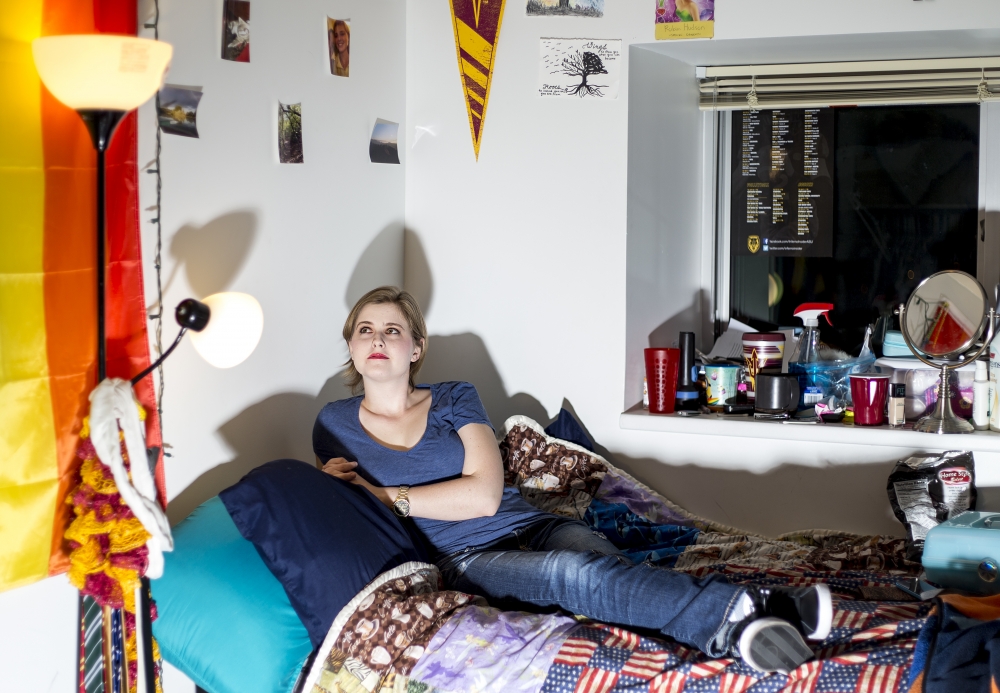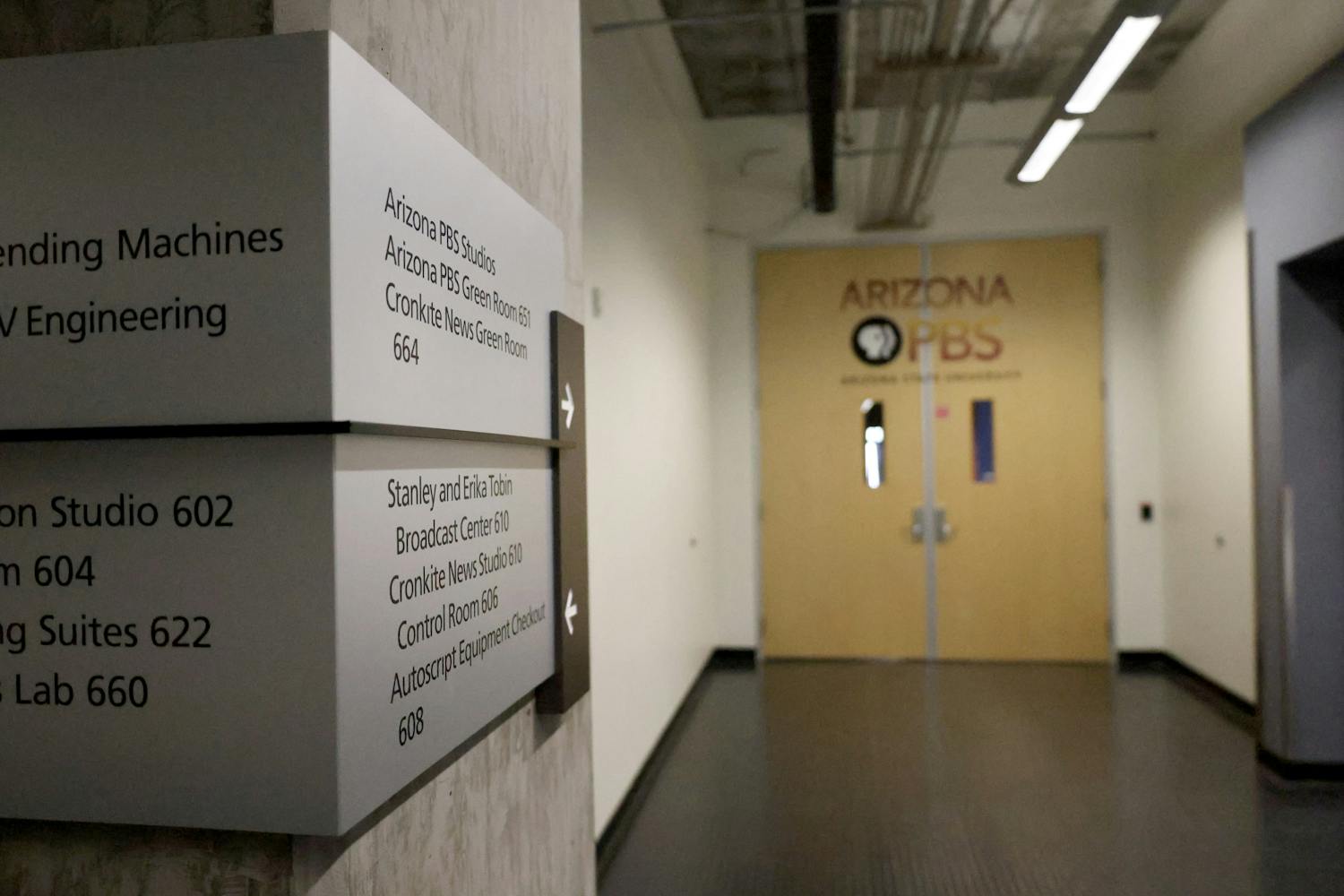Starry-eyed high school graduates annually trade the last four awkward years of their lives for the promises of college: unparalleled education, cultural experimentation and affectation of change — the likes of which previously seemed reserved only for the greatest among them.
The cost of a degree can cause even the boldest of dreamers to bring their foray into higher education to a screeching halt, though. For public policy junior Robin Hudson, the idea of paying for college was one she hadn’t even considered before her time at the University began.
Hudson was awarded a scholarship her freshman year at ASU, and was looking forward to going through four years at the school without any incidents of extreme sticker shock. The promise of the scholarship was one of many factors that led Hudson to choose ASU over other institutions.
However, after her freshman year, Hudson lost her scholarship. Freshman Merit Scholarships, part of ASU's New American University Scholar program, apply to the incoming student’s first year. After that year is completed, the student can apply to renew the scholarship for additional semesters. Hudson’s request to renew was denied, she said.
ASU Dean of Admission and Financial Aid Services Melissa Pizzo said the University has to make many financial aid decisions on a case-by-case basis. Some students may lose scholarships or other financial aid simply because the University does not have adequate funds at the moment, Pizzo said, though she could not address any particular student's case.
“Part of the reason I came to ASU was I had a good scholarship,” Hudson said. “I guess, at this point, the loans are a necessary evil.”
ASU Student Discusses Student Debt from The State Press on Vimeo.
With no scholarships, Hudson sought the help of her family in paying for college. Much to her dismay, however, they were denied ASU’s Parent PLUS Loan. Hudson’s parents were told they were financially ineligible to qualify for the loan, she said.
Parent PLUS Loans do not come directly from ASU. Rather, they come from the federal government, according to the University. The U.S. Department of Education determines whether a family’s credit makes them eligible.
According to the University’s financial aid information, the Parent PLUS Loan has a fixed interest rate of 6.84 percent. Once the first disbursement is made to the student’s account, interest starts accruing.
However, the average interest rate of the U.S. in 2014 was 1.8 percent — less than a third of the interest rate on the Parent PLUS Loan, according to the World Bank.
Hudson then had to scramble for a way to pay for college. Without scholarships or the help of her parents, she turned to private loans.
“I took out a private loan from Sallie Mae, which I equate to selling my soul,” Hudson said.
Hudson's loans currently have her about $58,000 in debt. Upon graduation in the spring of 2017, Hudson expects to be at $70,000, significantly higher than average for ASU graduates.
Hudson, a Colorado transplant, has to pay out-of-state tuition. She has to borrow more money than Arizona residents to make up the difference in the cost of her education.
Taking out student loans and dropping out can make it even more difficult to pay back the loans in the future. Students like Hudson often stay the course so they have more means to pay them back in the future.
According to a study from the Institute for College Access and Success, the average 2014 alumnus from ASU had nearly $22,000 in student loan debt upon graduation, roughly two years’ worth of tuition. Of the 2014 class, 54 percent were graduating with debt, the study reported.
Hudson’s loans are already accruing interest, which she said concerns her.
“I care about interest rates, because interest rates are what get you in the end,” Hudson said.
She is currently paying $50 every month on her private loan. By doing this, she ensures her monthly payment after graduation will be $500, rather than $800.
As a result of Hudson’s current payments toward her loan, she has to work outside of school to help make ends meet.
“I feel like I’m being cheated out of money,” she said. “I’m spending more time at work than in class.”
In addition to paying for her tuition, Hudson has to pay for living expenses in the Downtown Phoenix campus' dorm rooms. She said she is looking for another place to live so she can keep costs as minimal as possible.
Beyond tuition, the cost of books, parking and food weigh on most college students. Hudson decided to take more hours at her job as a waitress and hostess to help cover these costs.
She dropped several classes last semester because her financial burdens caused her to grow anxious and lose attention in her studies, she said. To catch up and graduate on time, she is taking 20 credits this semester.
“It really makes me angry that I have to fight to graduate,” Hudson said. “I should be focused on graduating.”
After losing her scholarship, Hudson’s wild goose chase to somehow obtain money before the next semester led her down many paths. When she went to the University for help, she said she felt like no one was there to support her.
Her family was certainly willing to help, but without the aid of a loan, they were not able to give significant financial support toward the cost of college.
“As far as education, what I was signing up for, there was no help,” she said.
Pizzo, the dean of Admission and Financial Aid Services, said the school makes an effort to help students as much as possible when it comes to financial aid.
For academic year 2014-15, the school doled out around $1 billion in financial aid, Pizzo said. About 80 percent of students that year had some sort of financial aid, be it loans, scholarships or Federal Work-Study.
“Financial aid and college choice … and figuring out how you’re going to pay for college is a very individualized experience,” Pizzo said. “And so we do have the ability to work with students and their families one-on-one.”
What ASU offers
According to a statement from the University’s media center, ASU Now, the school is “committed to helping students succeed through graduation.”
ASU offers Financial Aid 101 on its website, which gives students an introductory crash course in different types of financial aid, as well as how and when students should apply for them.
The University also makes an effort to educate students on the financial aid system and how to navigate it, Pizzo said.
The school offers MoneyMoments through MidFirst Bank, a series of interactive web lectures, which enable students to learn about personal financial policies, how loans work and the like.
Upon request, the school provides information sessions on financial literacy to mandatory ASU 101 classes, Pizzo said. Beyond that, the school also hosts occasional workshops put on by the AZ Commission for Postsecondary Education, a division of the state government devoted to increasing college access and success.
These events allow students to bring their families and fill out FAFSA information with the help of the University and state government.
Students often find part-time work when scholarships and financial don't cover the entire cost of college.
“A student who’s working a position that’s minimum wage, $8.05 an hour, if they’re working 20 hours a week — academic year I’m going to say is 30 weeks — that’s about $4,800 (before tax),” Pizzo said. “I know a number of our students actually have positions and jobs that are paying $9, $10 an hour, so that is a way to help pay for college.”
Although working can help cover some expenses in college, Pizzo stressed the importance of staying a student first and not allowing work to get in the way of education.
Working a job outside of school can provide extra money for students, but is not always enough to cover the cost of their education.
Problems facing working students
Students also have to overcome a gargantuan unemployment rate affecting the job landscape for their age group. According to the Economic Policy Institute’s annual report from 2015, unemployment was at 12.3 percent for individuals under the age of 25. It was 5.5 percent for the rest of the nation.
For high school graduates, the unemployment rate was 19.5 percent, making it even more difficult for incoming freshmen to find a job while juggling classes and increasingly important internships.
For college students fortunate enough to balance employment with their education, they often can only handle a part-time job. Living on a part-time income isn’t usually enough to pay for college and the cost of living.
The average weekly income of part-time and salary workers aged 16 and up for the fourth quarter of 2015 was $246, according to the Bureau of Labor Statistics.
The subset of workers between the ages of 16 and 24 only made $190 per week, though. That comes out to an annual income of less than $10,000 for a full year and about $6,000 for an academic year. In-state tuition at ASU often lies between $10,000 and $11,000, depending on the program studied, according to the University.
Hudson said she stays in Arizona over the summer, rather than going home to see her family, so she can work extra hours and attempt to save money.
Once summer ends, though, the reality of balancing work with school sets in, and the burden she signed up for by being a working a student begins its visceral, increasingly tumultuous cycle, leaving her financially crippled.
“It’s like a never-ending story,” Hudson said.
Ultimately, students don’t have a lot of immediate alternatives to taking out loans, she said. Either they can pay for college, or they can’t. Taking out large loans can leave a person exhausted, feeling like they have nowhere to turn.
“Something comes up and you either have to deal with it, or break,” Hudson said. “There’s no in-between.”
While caught in the battle between dealing with her situation and breaking, Hudson said she felt alone, unsure of where to turn for help with the stress brought about by her five-figure debt.
She said she sees the University increasing its efforts to help students navigate the financial aid system, but would like to see those efforts increase even more.
“I think there has been a slight change, but I think it’s politically motivated, because the next (presidential) elections are coming up,” she said. “The University is working with us to get more aid from the state.”
The future, which lies on the horizon, is obscured by backbreaking student loan debt for Hudson. She is considering enlisting in the military upon graduation to pay back her loan debt.
Loan debt after graduation
Financial aid does not only affect students while they are in college. Rather, it bears down on them more harshly after graduation. Of the $12 trillion dollars of consumer debt in the country, $1.2 trillion is student loan debt, according to the Federal Reserve Bank of New York.
Credit card debt in the U.S. is a comparatively small $714 billion, according to the bank. The only form of consumer debt greater than that of student loans is mortgage debt, at $8.26 trillion.
Student loan debt isn’t a problem reserved for alumni; it also threatens those currently enrolled in school.
Ryan Boyd, the vice president of policy for ASU’s Undergraduate Student Government Downtown, works first-hand with students experiencing hardships or uncertainty when navigating the financial aid system.
Through his work, Boyd has found some solutions students can use to minimize the possibility of owing large amounts after graduation.
“Our goal has been to lower the cost of attendance,” Boyd said. “If we can expand financial aid offerings, that would help tremendously.”
Boyd said the amount of financial aid directed toward ASU from the state of Arizona amounts to a drop in the bucket. If that aid could be maximized, the school could get started on the road to solutions, he said.
The Arizona Financial Aid Trust has about $10 million on hand, according to the Arizona Board of Regents. Boyd estimated approximately one-half of a percent takes the form of financial aid at ASU.
Allocating state dollars toward the University is usually a priority for the USGD when the state is not in the middle of education budget cuts, Boyd said. As a result, it’s been shelved as a long-term goal for the time being.
USGD serves as the last defense for students unsure of the paperwork and legalese that comes with financial aid, Boyd said.
"People come to us when there’s nowhere else to go,” he said. “The most general pattern is that people don’t really ask for help until it’s too late.”
Boyd said students in such a position usually have even fewer options available to them.
“The biggest problem with financial aid is that every case is different,” he said.
The Downtown Phoenix campus of ASU is unique in that many of the disciplines are not necessarily known for fertile job markets or inexpensive schooling, Boyd said.
“This campus is not the financially motivated campus,” he said. “This is the compassionate campus.”
This poses a problem to students after graduation. With the exception of medical professions, many of the specializations offered at the downtown campus do not offer high-paying salaries for entry-level positions. This adds to the student debt problem facing the country’s somewhat-recovering economy.
As if the sheer amount of student loan debt in the country was not high enough, the delinquency rates (percentages representing the total balance overdue by 90 days or more) are higher than any form of consumer debt in the country, according to the Federal Reserve Bank of New York.
The 90-day plus delinquency rate for student loan debt in the third quarter of 2015 rested at 11.6 percent, more than the rates for mortgage and credit card debt combined, which were 2.3 and 8.2 percent, respectively.
Those numbers are misleading, though, according to the bank. Delinquency rates for student loans do not paint a full picture, because students who are still in school and have not yet begun paying off their loans are included in the statistic of 11.6 percent.
About 50 percent of loans are in grace periods, deferment or forbearance, meaning the loan-takers are not currently making payments on them. According to the bank, loans in the repayment cycle actually have a delinquency rate roughly double the 11.6 percent represented.
Other financial options
Boyd said students do have alternatives to loans, but the alternatives are not always obvious ones.
These alternatives are not necessarily available to all students equally, but can serve as stepping stones into a wider conversation about what can be done to make college an attainable reality.
Boyd said tuition waivers are an excellent way for students to get through college.
Tuition waivers often come with a job, such as a police aide. The student works for a paycheck, but also receives a waiver on the semester’s tuition, and sometimes a waiver for books as well.
A tuition waiver is not a catchall solution, Boyd said, as they can be competitive and generally lean toward upperclassmen.
Boyd said students should look for scholarships, beyond those offered by the school.
“The scholarship portal does some things, but it ain’t the end-all, be-all,” Boyd said. “It’s a good list, but it’s not the whole list.”
Private scholarships can be difficult to find, and often come in small amounts, meaning students have to piecemeal several of them together to pay for college. Although they can be difficult to obtain, private scholarships are another tool for students to utilize.
Participating in a Work Study makes more options available to students, if they can find one, Boyd said.
“Work Studies aren’t big at Arizona universities, and that’s not by randomness, that’s by design,” Boyd said. “From a federal level, work study dollars are allocated to people who already have work study dollars.”
In other words, since ASU is the largest public university in the country, and happens to be in a state rife with budget cuts affecting education, it often receives fewer Work Study positions than other schools.
Although Gov. Doug Ducey proposed a budget in January allocating an extra $4 million to state universities, Boyd said he does not see that money making much of a difference. Ducey’s office did not respond to request for comment.
Boyd said schools are not entirely to blame for problems in the financial aid system. People bear a responsibility to become financially literate, and policy makers have a responsibility to make financial aid available to the middle class, as well as the lower class.
“There’s a lot of financial aid for those in the lowest socioeconomic levels because they’re the ones we think of first,” Boyd said.
Those in the middle class are often unable to finance a trip to college out-of-pocket, yet they usually make too much money to qualify for many forms of financial aid.
Boyd said filling out FAFSA information is the first step a student should take in navigating the murky depths of the financial aid system.
“Big things you should do: Fill out the FAFSA,” Boyd said. “Talk to financial aid, whether you need it or not.”
Finally, students should talk with their families about how they are going to pay for college.
“It’s a hard conversation, but it’s one you need to have,” Boyd said.
Boyd's advice rings true for students like Hudson, who said she would have been more cautious when signing loans if she had more knowledge on the subject at the time.
“I definitely signed before I understood everything,” she said.
Related Links:
President Obama continuing efforts to lessen burdens of student loan debt
ASU students try to revolutionize student loans
Reach the reporter at jwbowlin@asu.edu or follow @mrjoshuabowling on Twitter.
Like The State Press on Facebook and follow @statepress on Twitter.





